Published
on 19
Feb 2021
|
All rights reserved.
|
|

|
|
The
third generation 500 becomes an electric car, one that as good as it
looks.
|
|
This is not exactly the
first electric 500. 8 years ago, Fiat introduced 500e to the US market
solely to satisfy the ZEV requirement of California. It was heavily
modified from the regular 500, so the production cost was so high that
the late Sergio Marchionne complained that each car lost $10,000. It
goes
without saying the car barely sold.
The second generation “Nuova 500” is a completely different product. It
is built on a dedicated skateboard electric car platform (the first of
its kind in the entire FCA group as well as Stellantis). Naturally, it
shares nothing with the existing, petrol-powered 500. Neither will
it replace that aging model, because they belong to different class.
Pick the mid-spec. Icon trim for example, it is priced at 30,000 euros,
double the price of the existing 500. Even the entry-level model with
smaller battery starts at 25,000 euros, so it is no longer an A-segment
car in any sense except size. Therefore, the existing 500 will soldier
on for a few more years, probably as long as emission regulations
allow. It still sells very well in Europe, capturing as many as 170,000
sales in 2019. The new 500 electric slots above it and competes with
B-segment electric cars such as Renault Zoe, Peugeot e-208, Opel
e-Corsa and Citroen e-C4, and in particular iconic electric cars like
Honda
E and Mini Cooper SE. It is being built at the Mirafiori plant in Turin
with a capacity of 80,000 cars a year. Meanwhile, production of the
conventional 500 remains in Poland.

|
|
The
interior is a vast upgrade from the 500 before.
|
|
The 500 Electric has grown in all dimensions: 61mm in length, 56mm in
width, 39mm in height and 22mm in wheelbase. It is still a mini car
though, offering no better than 2+2 seating. You get more head and
shoulder room up front compared with the existing 500, which is fine
for drivers of any sizes. Losing a gearstick frees up a little knee
room. You sit a little bit higher, too, but not too much compared with
the old car, which was high anyway. The driving position is improved by
a steering wheel finally adjustable for reach and rake, while the new
front seats are more comfortable. The rear seat remains suitable for
only children though, or short adults for emergency use, and the boot
is just large enough for no more than a couple of soft bags. As before,
the 500 is a personal city car.
The interior design and finish are definitely lifted to a higher level.
While most
plastics used are still hard ones, they are well textured to look
high-quality. The dashboard is also shaped, colored and decorated to
look far classier than the old car. Equipment level is high, especially
the top trim with 10.25-inch touchscreen. It gets even adaptive cruise
control and lane keeping function, something a class’ first. Cabriolet
model comes with a Canvas top again, which adds a little bit weight
but hurts little structural rigidity. The fabric roof slides back and
down in 25 seconds, and this can be done at up to 100 km/h.
The packaging of this car is outstanding. If there are any city cars as
cute, funky yet classy and Sci-Fi, we have not seen yet. Remarkably,
Fiat keeps the iconic shape of the 2007 model that was designed by
Frank Stephenson, but refine it and modernize it further. Rough edges
have been rounded, while elegant features are introduced. There are
many clever touches, such as turning the headlamps to semi-circles and
completed its second half with LED turning indicators on the bonnet. As
before, the nose section is free of grille, but instead of the Fiat
logo it has the 500 logo stamped. This also implies that 500 becomes a
sub-brand.
 |
|
It
has a charm that none of its rivals could match...
|
|
With such a great exterior and interior packaging, only a particularly
poor underpinnings could ruin its chances. Fiat is not going to let
this happen, of course.
In terms of engineering innovation and execution, the electric 500
might not be outstanding, but it is more than good enough for its
purpose, i.e. working as an urban transport. Its electromechanical
layout is pretty conventional in the context of modern electric cars: a
front-mounted permanent magnet motor, front-wheel drive only,
single-speed gearbox, lithium-ion battery placed under floor and within
the wheelbase, MacPerson struts and torsion-beam suspensions. The base
model employs a small, 23.7kWh battery which is good for only 180km
range (112 miles), and a 95hp motor good for 0-60 sprint in about 9
seconds. Thanks to the small battery, it tips the DIN scale at 1255kg,
remarkably light for an electric car. However, most buyers will opt for
the longer range model with 42kWh battery, 320km range (200 miles),
1365kg kerb weight, 118hp motor and 0-60 taking 8.5 seconds. This model
compares favourably with its key rivals Honda E (35.5kWh, 222km) and
Mini Cooper SE (32.6kWh, 230km). Although Renault Zoe and PSA’s trios
offer larger battery and longer range still, the Fiat undercuts them
significantly in price. It offers outstanding value for money.
In terms of charging, it is competitive as well. Higher spec. models
offer an on-board 85kW DC quick charger, which can charge the battery
from depleted to 80 percent full in 35 minutes.
 |
|
Decent
dynamics and good driving range are achieved with an affordable price.
|
|
So how does it drive on the road? Pretty good. As with any other EVs,
it starts and runs smoothly and silently – moan about lacking the raw
excitement of 500 TwinAir. The major
sources of noise come from wind and tires, but not excessive. The
electric motor offers brisk acceleration off the line, fades out at
higher speeds while top speed is capped at 93 mph. You can select
conventional driving style or 1-pedal driving mode with strong
regenerative braking. Nothing surprising, nothing disappointing.
Despite the tallness and short wheelbase, its center of gravity is low,
and the wheels are pushed outwards like an Abarth model, so the
handling is not bad. It resists roll well while the ride is slightly
but not overly firm, certainly more refined than the existing 500. The
tires offer plenty of grip. The steering is very light but accurate.
Overall, the handling is agile yet predictable. In urban area, the
car’s small dimensions, tight turning circle and light steering make it
remarkably easy to place and park.
It is no Mini Cooper SE for driver appeal, nor as refined as Honda E,
but Fiat’s first dedicated electric car has a charm that none of its
rivals could match. Moreover, it has a more practical driving range yet
a considerably lower price tag. If you can live without full-size back
seats, this is the perfect urban EV to have.
|
Verdict:     |
Published
on 1
Jun 2023
|
All rights reserved.
|
|
Abarth 500e
|
|

|
|
Abarth's
new warm hatch is inviting and impressive, if not what you would expect
from the brand.
|
|
Instead of a hot hatch,
the Abarth 500e is more like a “warm hatch”. There will be a hotter
Abarth model in the mold of 595 or 695 to join in the future, but a
milder, cheaper and more accessible model will undoubtedly attract
bigger sales, just like Ford’s ST-Line or Hyundai’s N-line.
In the age of EV, creating a warm hatch cannot be easier. To lift
output from 118 to 155 hp and torque from 162 to 173 lbft, you just
need to supply the unchanged electric motor with more current. This can
be done by using a more powerful inverter and wider gauge cables,
keeping cost to the minimum. If that’s not powerful enough, shorten the
fixed gear ratio from 9.6 to 10.2 will improve 0-60 mph acceleration
further to 6.6 seconds, compared with 8.5 for the standard car. On the
flipside, top speed is lifted just slightly to 96 mph owing to the
revised gear ratio. The Abarth 500e is definitely not developed for
track abuse.
By keeping the 500e’s relatively small battery (only 42 kWh gross or 37
kWh net), weight can be controlled to a reasonable 1410 kg. Yes, that
might be close to a much larger Civic Type R, but in the EV world it is
nearly the lightest car you can buy – lighter than a Peugeot e-208,
lighter than a Renault Zoe, lighter than Honda E. Only a Mini Cooper SE
is lighter still, but that car employs an even smaller battery for a
dismal range. The Abarth is not a mile-eater either, but it can travel
up to 164 miles on WLTP cycles or about 130 miles in the real world,
thus can satisfy the needs of most motorists. After all, with limited
rear seat and luggage space, the little Abarth is supposed to be
primarily a city car with B-roads capability rather than a
transcontinental tourer.
On the road, just as expected, the instant release of peak torque makes
the little Abarth feel brisk. At lower speeds it is significantly more
responsive than the off-boost 595. Once up to the threshold of legal
speed, however, it tails off quickly. Still, the bespoke “sound
generator”, which is a waterproofed external subwoofer, produces
artificial noises that mirror a petrol engine and adds to the drama. At
mid-range speed it might be a bit wearing, but on highway it settles
down, and you can turn it off if you don’t like.
The Abarth version also gets stiffer springs and dampers, larger brakes
and recalibrated steering. Bespoke tires offer more grip, while you can
opt for great-looking 18-inch wheels. Its handling is sportier than the
standard 500e, but not as sporty as a true hot hatch like Fiesta ST or
i20N, of course. For many drivers, it is a well-judged middle ground,
offering just enough body control and grip without sacrificing ride
comfort and refinement too much. The steering is light but precise. The
car turns in keenly and resists understeer better than the petrol
version, thanks to better weight distribution and wider tracks. The
balance is good, as lift-off mid-corner will tighten its nose. The
brake is responsive, too. Overall, the Abarth feels quite engaging to
drive on interesting roads, albeit at a lower limit than a proper hot
hatch. Meanwhile, the chassis feels a lot stiffer than the 595, thanks
in part to the underfloor battery, which is evident in ride and
refinement.
Such maturity is mirrored in the cabin. Like the standard 500e, it is a
night-and-day difference from the old 500. The build quality is good,
the design is stylish and the technology is up to date. You face a
digital instrument and a 10.25-inch touchscreen. The higher trim option
brings Alcantara trims to the dashboard, steering wheel and seats to
supplement leather, making this place very cool and expensive-feeling,
almost an AMG. The bucket seats are supportive, and the driving
position is beyond the usual standard of Fiat.
Then again, at £38,000, the Abarth is a little premium car. The
base car with 17-inch wheel, without Alcantara trim and glass roof
costs a more reasonable £34,000 – not overpriced for a small
urban EV. Like the standard 500e, it is an attractive package. However,
if you expect it to be a hot hatch, living up to the badge of Abarth,
you might be a little disappointed, especially concerning the lack of
sustainable punch at higher speeds. That might be fulfilled by the
upcoming hotter Abarth model, but that car will demand a higher price
again.
|
Verdict:    |
|